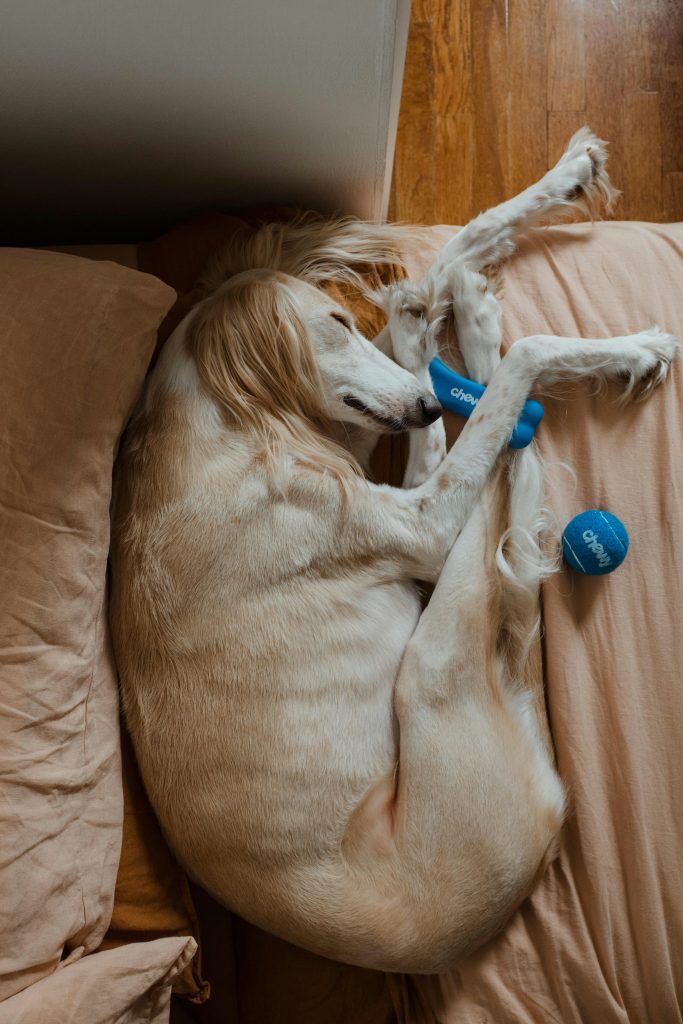Discover the evolutionary basis of dog sleeping positions and how they reveal their comfort, health, and social interactions, including the Superman position indicating deep relaxation, the curled-up position for warmth and security, and the on-back position showcasing trust and submission within the pack hierarchy.

I. Understanding Dog Sleeping Positions
Dogs exhibit a wide range of sleeping positions , each with its unique significance in reflecting their comfort level, health, and evolutionary behaviors. These positions are not merely random postures but are deeply rooted in the evolutionary history of dogs. For instance, the “Superman” sleeping position, where a dog stretches its legs out behind and front legs forward, is more than just a posture; it symbolizes a state of deep relaxation. This position not only indicates a dog’s comfort but also its trust in the environment and pack members.
Furthermore, the different sleeping positions dogs assume can be linked to their ancestral pack behaviors and survival instincts. For example, when dogs curl up in a ball while sleeping, it is an instinctual behavior aimed at conserving body heat and protecting vital organs. This position not only showcases their adaptability and sense of security but also mirrors their survival strategies in the wild. By delving into the evolutionary underpinnings of dog sleeping positions, we can gain profound insights into their natural tendencies and the ways in which they navigate their social interactions and environments.
II. The “Superman” Sleeping Position
The “Superman” sleeping position, where a dog stretches its legs out behind and front legs forward, signifies a state of deep relaxation and comfort. Dogs adopt this position to express trust in their environment and pack members, showcasing their need for safety and security. By assuming the “Superman” position, dogs emphasize their reliance on their pack for protection and their desire for a stress-free rest.
Furthermore, the “Superman” sleeping position not only indicates physical relaxation but also mental peace. Dogs in this pose show a willingness to let their guard down and be vulnerable, highlighting their strong bond with their pack members and their environment. This position is reminiscent of a superhero soaring through the sky, symbolizing a sense of freedom and contentment that dogs feel when they are at ease in their surroundings.
Moreover, the “Superman” sleeping position is often observed in dogs who have a strong sense of trust and connection with their owners. When a dog stretches out in this manner, it can also signal a deep emotional bond and a profound level of attachment to their human companions. This position not only showcases the dog’s physical comfort but also their psychological well-being, illustrating the importance of security and trust in fostering a harmonious relationship between dogs and their owners.

III. The Curled-Up Position
When dogs curl up in a ball while sleeping, they are not only conserving body heat but also protecting their vital organs, reflecting their instinctual behaviors and adaptability. This position symbolizes a sense of security and comfort, mirroring their survival strategies in the wild. By curling up, dogs create a cozy and safe sleeping environment, highlighting their innate need for warmth and protection.
The curled-up position is not only a physical posture but also a psychological state that demonstrates a dog’s ability to adapt to different environments. This sleeping position can also be a manifestation of a dog’s emotional well-being, as it provides them with a sense of security and peace. Dogs may choose to curl up when they feel stressed, anxious, or simply seeking comfort, showcasing their versatile nature in responding to their emotional needs through physical actions.
Moreover, the curled-up position allows dogs to quickly transition from sleep to an alert state if needed, indicating their readiness to respond to any potential threats or changes in their surroundings. This adaptive behavior reflects the evolutionary traits of dogs, where survival instincts play a crucial role in their daily routines, even when in a vulnerable state such as sleep. The next time you see your furry friend curled up in a ball, remember that it is not just about staying warm but also a way for them to feel safe, secure, and emotionally balanced.
IV. On-Back Sleeping Position
The on-back sleeping position, where a dog lies on its back with its paws up in the air, is a fascinating behavior that carries significant meaning in the canine world. This position goes beyond merely showing trust and submission; it also unveils a dog’s deep-rooted evolutionary instincts and social dynamics within a pack. When a dog chooses to sleep in this exposed posture, it signifies a profound level of vulnerability but also a high sense of security within the pack structure.
Moreover, the on-back sleeping position is not just a physical display but a psychological one as well. Dogs that sleep in this manner are not only trusting their pack members for protection but also showcasing their faith in the overall harmony and safety of their environment. This behavior highlights the intricate balance between vulnerability and trust that dogs navigate daily, emphasizing the importance of social bonds and cooperation within a pack setting. An example of this can be observed when a dog peacefully snoozes on its back, legs in the air, next to its human family members, symbolizing a deep sense of belonging and reliance on their care and protection.

V. Environmental Influences on Sleeping Positions
Environmental influences play a significant role in shaping a dog’s sleeping positions, showcasing their adaptive nature and sensitivity to external stimuli. For instance, temperature fluctuations can affect how a dog chooses to sleep, with colder temperatures often leading dogs to curl up in a ball to conserve body heat and stay warm. On the other hand, in warmer conditions, dogs may opt for more sprawling positions to cool down and prevent overheating. This flexibility in sleeping postures highlights dogs’ ability to adjust to their environment for optimal comfort and health.
Moreover, noise levels in the surroundings can impact a dog’s sleep position choices. Dogs may prefer more secure and enclosed positions, such as curling up in a ball, when exposed to loud or unfamiliar sounds to feel protected and shielded from potential threats. Conversely, in quieter environments where they feel safe and relaxed, dogs may stretch out in more vulnerable positions, indicating a higher level of comfort and trust in their surroundings. This adaptive behavior demonstrates how dogs prioritize their safety and well-being based on the environmental cues they perceive.
 VI. Connection Between Sleeping Positions and Pack Behavior
VI. Connection Between Sleeping Positions and Pack Behavior
Dog sleeping positions are intricately linked to their pack behavior, offering insights into their social dynamics and hierarchical structures within a group. Observing how dogs interact during sleep and select their positions can provide valuable information about their roles within the pack, their level of comfort, and their relationships with other pack members. The choice of sleeping position serves as a subtle indicator of a dog’s position in the pack hierarchy, their trust in pack members, and their overall well-being.
Understanding the connection between sleeping positions and pack behavior is essential in deciphering the intricate social lives of dogs. For example, when a dog curls up in a ball while sleeping, it not only reflects their need to conserve body heat and protect vital organs but also demonstrates their innate ability to adapt and feel secure within their pack. This behavior resonates with the principles of pack behavior, where each member plays a specific role in ensuring the collective safety and well-being of the group.
Moreover, the on-back sleeping position, indicating trust and submission, is deeply rooted in the evolutionary history of dogs as pack animals. By exposing their vulnerable belly and extending their paws in the air, dogs exhibit a level of trust in their pack members, mirroring the dynamics of trust and reliance within a pack structure. This position not only highlights the importance of submission in maintaining harmony within the group but also showcases the significance of mutual respect and understanding among pack members.
